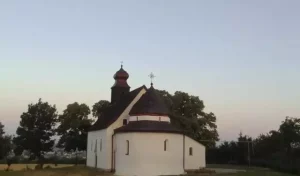🕒 Date of last update of the article: 13.04.2024 at 11:17 p.m | 🖋 Author: Viktor Shatrov
Надсилайте актуальну інформацію та отримуйте більше цільових клієнтів. Ми розмістимо ваш об’єкт у нашому каталозі та покажемо поруч із локаціями, а також у загальному каталозі, це безкоштовно!
🕒 Date of last update of the article: 13.04.2024 at 11:17 p.m | 🖋 Author: Viktor Shatrov
Getting to know Uzhhorod would be incomplete without a visit to the famous Horyany Rotunda, which is one of the oldest monuments of sacred architecture in Ukraine. Believers have been coming here to pray for almost 1000 years. The rotunda was recently restored and re-consecrated in January 2007. The architectural monument is located four kilometres east of the central part of Uzhhorod, on a rocky outcrop of the Antalovetska Polyana, which is part of the Vyhorlat-Hutynskyi ridge. It offers a magnificent view. It is from the Horyany Rotunda that the City Day has been celebrated in recent years.

Content
| 🗺 Location | N48°36′22″ E22°20′13″ |
| 🔰 Status | An architectural monument of national significance of Ukraine |
| 🏛 Building type | Catholic Church |
| ⛪ Status | Last restoration – in 2007 |
| 👩🦳 Patroness | St. Anna |
| 🧭 Distance from the center of Uzhhorod | 4 km |
| 🚙 Road for | Car, on foot |
| 🏕 Stop with a tent | No |
| 🏡 Housing nearby | Uzhhorod |
| ☕ Cafes and shops | Uzhhorod |
| 🌍 Address | 2 Muzeinyi lane, Uzhhorod, Transcarpathian region |
| 🕒 Work schedule | Every day from 8:00 AM to 4:00 PM |
| ☎ Telephone number for inquiries | (066) 492 72 85 |
| 💳 Entrance fee | Entry is free |
The formerly independent administrative-territorial unit, the village of Horyany, became part of the city of Uzhhorod in the early 20th century. According to one hypothesis, Uzhhorod originated not from Zamkova but from Horyany Hill. Indeed, just above the rotunda are the ruins of either a palace or an ancient monastery, which locals call a “hillfort”.
It is an indisputable fact that part of this church of St Anne, the rotunda with narrow windows, is the oldest example of stone architecture in Uzhhorod. Its two-metre-thick walls testify to its antiquity.
There are many versions about the age of the rotunda’s foundation: from the IX to the XII century. The nave and sacristy of the church were built later – in the XIV-XV centuries. The glory of the Horyany Rotunda was brought by the unique frescoes found under the putty during the renovation in 1879. A preliminary scientific analysis has already established that this is a mural of the XIII-XIV centuries. The frescoes are painted mainly in cold colours and depict well-known scenes:
Apparently, the author of the frescoes was familiar with the works of Giotto, the forerunner of the Italian Renaissance. There is a version that the frescoes on the walls of the rotunda were commissioned by the owner of the Uzhok dominion, György Druget, an Italian by birth.
In 1960-1962, the frescoes were restored. Improper repairs in the early 1990s almost led to a disaster: the humidity level in the church increased, and the frescoes were threatened with extinction. Fortunately, funds were found to heat the church and replace the tin roof with shingles.
Another unique feature of the Horyany Rotunda is that it has five (and once six) radially placed apses inside, while temples of this type usually had eight such niches. Thus, the Horyany Rotunda is a regular hexagon in plan.
| 🔰 Start | From the parking lot |
| 🚶 Walking distance | A walk through the territory of the attraction |
Author of the article: Viktor Shatrov
Number of articles: 1100+
Knowledge of languages:: Ukrainian, English
Favourite quote: “Travelling – the only thing that makes you richer“
He was born and lived all his life in Uzhhorod. He graduated with a gold medal from Uzhhorod School No. 1 named after Taras Shevchenko (now Uzhhorod Lyceum named after Taras Shevchenko). He studied at the History Department of UzhNU, graduating with honours in 2009. He worked as a senior researcher at the Transcarpathian Museum of Folk Architecture and Life, a lecturer at the East European Slavic University.